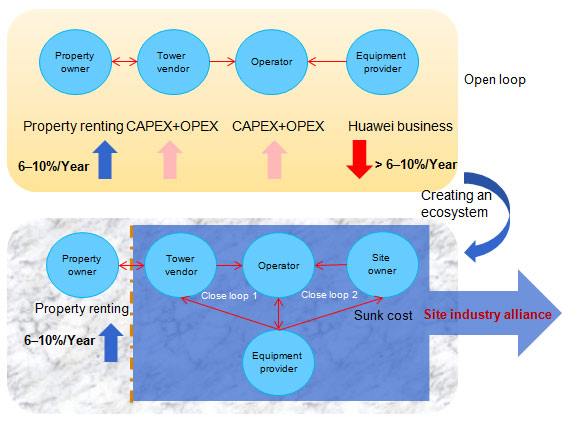A Site Industry Alliance in South Pacific Helps Accelerate MBB Development
1. Methods of Achieving Structured Growths in South Pacific
Connections increase explosively in the South Pacific's market with rapid MBB development. Network capabilities depend on spectrum resources, sites, standards, and multi-channel and multi-sector technologies. Insufficient spectrum resources, slowly-released new spectrums, and existing sites and technologies only support 58% of services on the entire network in South Pacific. The left services require new sites to carry. Site addition is then the prerequisites for mainstream operators in the region to develop. Site is king while spectrum is gold.
Under the following circumstances, site addition is a breakthrough for helping operators quickly deploy B2B services and achieve structured growths.
1)Indonesia, the Philippines, and Malaysia now have the lowest site density in the world. These facts hinder the service development and other sustainable development of operators in the places.
2)According to the researches on the available site resources in these three markets, massive resources, such as wire poles and lamp poles, can be used together with traditional tower-top sites. There are about 530 thousand, 70 thousand, and 60 thousand poles in Indonesia, the Philippines, and Malaysia, respectively. Besides, thousands of chain supermarkets and over 4000 large-sized buildings can act as potential site locations.
3)It is found that, during site deployment, stakeholders in the industry chain have limited understanding on value. They focus more on current benefits while not fully understand the industry development, future value, and market space.
How to solve these tough problems? A site industry alliance is then established in the region.
2. Positioning and Essence of the Site Industry Alliance
After analyzing the ecosystem by observing the industry chain, it is found that the traditional industry chain is an open-loop system with more competition than coordination, increasing the difficulty in solving problems at present. When new strategic direction is determined in the region, the whole industry chain is reviewed again. Huawei, using its own advantages, find new value opportunity points for each stakeholder and help the industry chain create new values. Simultaneously, to build a harmonious ecosystem, two close loops are designed for different objects. One close loop puts emphasis on business scale and layout while the other one focuses on new business opportunities. With the industry alliance, the industry chain changes from an open-loop mode to a close-loop one. The industry alliance has then been strengthening.

Two essences of the industry alliance:
1.The industry alliance enables the entire industry chain to understand industry development and trend as well as current and future new values and market spaces.
2.Huawei, as the initiator, promotes the entire industry chain to create new values and achieve win-win results.
3. New Business Model Values of the Site Industry Alliance
The site industry alliance enables all stakeholders to benefit from the architecture.

1.Traditional tower vendors: The cooperation with Huawei helps tower vendors ensure fast large-scaled site deployment and change the passive site construction mode to active one.
2.Property/Large chain supermarkets:
- Existing resources create rental incomes and service revenues.
- New business opportunities (such as selling smartphones and operators' service packages) create new revenue sources.
- For indoor properties, Huawei uses indoor solutions to provide standard vertical application programming interface (API) and develops vertical industry services and applications together with other stakeholders, bringing new income sources for property owners, app developers, and operators and sharing the benefits.
3.Government: Improve the usage of public resources (including lamp poles, wire poles, bus stations, and public billboards) and activate public resources that can be reused to create more social values.
4. New Progresses Achieved by the Site Industry Alliance
In Indonesia: Huawei, through the site industry alliance, has signed with AlfaMart and IndoMart to rent XXXX supermarkets as site resources and with property company M to lease XXX buildings as potential indoor sites. There are over XXXX+ available and valuable sites now and the transformation of site locations to sites is widely progressed.
Huawei, together with the joint innovation center, organized the "Best App" competition for university students in Indonesia and launched the first app, enabling the SVA, and promoting students' training back to the country.

The Philippines: XXXX sites are acquired. The agile multi-scenario site deployment solution has been verified and delivered in the Philippines. The involved solutions are the street lamp pole solution in business districts, MRT/LRT transportation hub solution, and MSAN/Blade convergence solution. With the progress of site acquisition and selection, these solutions will be deployed in a large scale.
Malaysia: Operator U has cooperated with the Malacca tower vendor M to select XX towers as site locations, breaking the situation that there is no self-owned site in Malacca.
Operators have signed with NAZA on lamp pole sites as well as tested and verified site equipment for subsequent large-scale commercial deployment.
5. Vision of the MBB Industry Ecosystem in South Pacific
To ensure operators' business in the region, the MBB industry alliance is established for site densification, NB-IoT, and mobile videos with the main focus on site addition to strengthen wireless network capabilities. Huawei, together with operators and Indonesia University, has constructed capability opening platform and deliver values to the whole industry chain through the CSIC platform to construct a harmonious ecosystem, promoting the industry development.
